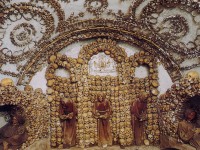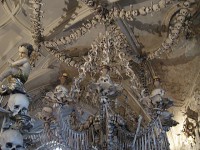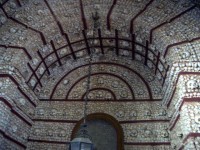 the Travel Enthusiast
the Travel Enthusiast
- 24 Oct
kachou_n in Amazing Places | NO COMMENTSThe weirdest bone churches in the world
If you’re a Christian, or even if you have ever visited a church in passing, your image of what a church should look like probably involves mostly neat rows of pews, stained glass windows projecting colorful lights on stone floors, and religious paintings depicting people with benevolent expressions.
Well, you can forget about all of this if you plan on visiting a bone church. Bone churches, common mostly in Europe but encountered in other parts of the world, make great travel attractions if you are not squeamish about human bones used as decorations. So give yourself a few delicious chills and visit some of the weirdest bone churches in the world.
Capuchin Crypt, Rome, Italy
The Capuchin Crypt is one of the most famous ossuaries in the world, even if it is rather tiny for a crypt. The crypt is located under the Santa Maria della Immacolata Concezione dei Cappuccini Church in Rome, and it is made up of small underground chapels decorated with the bones of Capuchin monks.
This was initially done for practical reasons: the soil in the crypt was imported from Jerusalem, thus considered holy, and in order to make place for newcomers, the old bones of the Capuchins buried there were put on the walls in various patterns.
Sedlec Ossuary, Sedlec, Czech Republic
The small town of Sedlec, within easy distance of Prague, would be overlooked by travelers if it weren’t for its magnificently creepy ossuary, located under the Church of All Saints.
The ossuary was used to deposit the bones of the people buried in the small cemetery near the church, to make room for new burials. In the 19th century, a local carver was hired to organize the mess of bones, which he turned into brilliant and imaginative compositions.
Hallstatt Karner, Hallstatt, Austria
In much of Austria, a person’s final resting place is not eternal, but rented out for a period of 10 to 30 years. After the lease is up, the rental period can either be renewed, or the grave goes to someone else, in which case the bones of the last occupant are placed in karners.
Hallstatt’s karner is famous in the country, and most of the 600 skulls on display are quite recent (the latest skull was added in the 80s), and lovingly painted with the person’s name and dates of birth and death.
Capela dos Osos, Evora, Portugal
While most bone churches are merely decorated with the bones of the dead, Capela dos Osos in Portugal looks as if bones had been the main building material used by the builders of the chapel.
The bones were glued together with cement to make the walls of the chapel, and there’s a grim poem at the door: “Our bones that are here await yours”.
- Flights
- Hotels
- Packages
- Cars
- Cruises
travel search by Travelgrove (get this widget)Catacombs of Paris, Paris, France
Perhaps the most famous example of a bone church in Europe (although technically not a church), are the old catacombs that cover a distance of 300 kilometers under the city of Paris. The bones of six million people have been collected in the catacombs over the centuries, because the city was running out of burial space.
You might also like




